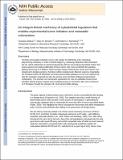| dc.contributor.author | Shibue, Tsukasa | |
| dc.contributor.author | Brooks, Mary W. | |
| dc.contributor.author | Weinberg, Robert A | |
| dc.date.accessioned | 2018-07-12T18:22:36Z | |
| dc.date.available | 2018-07-12T18:22:36Z | |
| dc.date.issued | 2013-09 | |
| dc.date.submitted | 2013-04 | |
| dc.identifier.issn | 1535-6108 | |
| dc.identifier.uri | http://hdl.handle.net/1721.1/116945 | |
| dc.description.abstract | Recently extravasated metastatic cancer cells use the Rif/mDia2 actin-nucleating/polymerizing machinery in order to extend integrin β1-containing, filopodium-like protrusions (FLPs), which enable them to interact productively with the surrounding extracellular matrix; this process governs the initial proliferation of these cancer cells. Here, we identify the signaling pathway governing FLP lifetime, which involves integrin-linked kinase (ILK) and β-parvin, two integrin:actin-bridging proteins that block cofilin-mediated actin-filament severing. Notably, the combined actions of Rif/mDia2 and ILK/β-parvin/cofilin pathways on FLPs are required not only for metastatic outgrowth but also for primary tumor formation following experimental implantation. This provides one mechanistic explanation for how the epithelial-mesenchymal transition (EMT) program imparts tumor-initiating powers to carcinoma cells, since it enhances FLP formation through the activation of ILK/β-parvin/cofilin pathway. | en_US |
| dc.description.sponsorship | National Institutes of Health (U.S.) (Grant P01 CA080111) | en_US |
| dc.description.sponsorship | National Institutes of Health (U.S.) (Grant U54-CA163109) | en_US |
| dc.publisher | Elsevier | en_US |
| dc.relation.isversionof | http://dx.doi.org/10.1016/J.CCR.2013.08.012 | en_US |
| dc.rights | Creative Commons Attribution-NonCommercial-NoDerivs License | en_US |
| dc.rights.uri | http://creativecommons.org/licenses/by-nc-nd/4.0/ | en_US |
| dc.source | PMC | en_US |
| dc.title | An Integrin-Linked Machinery of Cytoskeletal Regulation that Enables Experimental Tumor Initiation and Metastatic Colonization | en_US |
| dc.type | Article | en_US |
| dc.identifier.citation | Shibue, Tsukasa et al. “An Integrin-Linked Machinery of Cytoskeletal Regulation That Enables Experimental Tumor Initiation and Metastatic Colonization.” Cancer Cell 24, 4 (October 2013): 481–498 © 2013 Elsevier Inc | en_US |
| dc.contributor.department | Massachusetts Institute of Technology. Department of Biology | en_US |
| dc.contributor.department | Ludwig Center for Molecular Oncology (Massachusetts Institute of Technology) | en_US |
| dc.contributor.mitauthor | Shibue, Tsukasa | |
| dc.contributor.mitauthor | Brooks, Mary W. | |
| dc.contributor.mitauthor | Weinberg, Robert A | |
| dc.relation.journal | Cancer Cell | en_US |
| dc.eprint.version | Author's final manuscript | en_US |
| dc.type.uri | http://purl.org/eprint/type/JournalArticle | en_US |
| eprint.status | http://purl.org/eprint/status/PeerReviewed | en_US |
| dc.date.updated | 2018-07-12T17:24:38Z | |
| dspace.orderedauthors | Shibue, Tsukasa; Brooks, Mary W.; Weinberg, Robert A. | en_US |
| dspace.embargo.terms | N | en_US |
| dc.identifier.orcid | https://orcid.org/0000-0002-0895-3557 | |
| mit.license | PUBLISHER_CC | en_US |
